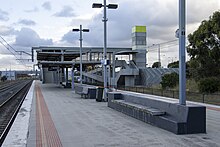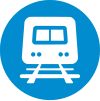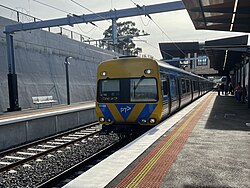|
Craigieburn line
The Craigieburn line is a commuter railway line in the city of Melbourne, Victoria, Australia.[1] Operated by Metro Trains Melbourne, it is the city's seventh shortest metropolitan railway line at 27.0 kilometres (16.8 mi). The line runs from Flinders Street station in central Melbourne to Craigieburn station in the north, serving 21 stations via North Melbourne, Essendon, and Broadmeadows.[2] The line operates for approximately 19 hours a day (from approximately 5:00 am to around 12:00 am) with 24 hour service available on Friday and Saturday nights. During peak hour, headways of up to 5 minutes are operated with services every 20–30 minutes during off-peak hours.[3] Trains on the Craigieburn line run with a two three-car formations of Comeng or Siemens Nexas trainsets.[4] Services on the line began from North Melbourne to Essendon by the Melbourne & Essendon Railway Company in November 1860. It was closed shortly after, however, the Victorian Railways reopened the Flemington Racecourse line (including the Essendon line as far as Newmarket) in November 1867, and in January 1871, to Essendon.[5] The line was progressively electrified and, in 1921, the line was electrified to Broadmeadows, where it remained until the extension of electrification in 2007.[5] Since the 2000s, due to the heavily utilised infrastructure of the Craigieburn line, improvements and upgrades have been made. Works have included replacing sleepers, upgrading signalling technology, the extension of the line to Craigieburn, the construction of new stations, the removal of level crossings, the introduction of new rolling stock, and station accessibility upgrades.[6] History19th centuryThe line from North Melbourne to Essendon was opened by the Melbourne & Essendon Railway Company in November 1860.[7] Soon after, the company opened a branch from Newmarket to Flemington Racecourse.[7] Both lines were closed shortly after, in July 1864. The Victorian Railways reopened the Flemington Racecourse line (including the Essendon line as far as Newmarket) in November 1867, and in January 1871, to Essendon. In April 1872, the line was extended to a temporary terminus outside Seymour, awaiting completion of a bridge over the Goulburn River. In December 1894, through services were provided from Essendon to Brighton Beach on the Sandringham line.[8] 20th centuryAutomatic Block Signalling was introduced on the line in 1918, with Kensington to Essendon being converted in June of that year, and North Melbourne to Kensington in October. In May 1919, Flinders Street to Essendon and the Sandringham line were the first lines to be electrified in Melbourne, apart from a test installation on the Flemington Racecourse line.[5] In 1921, the line was electrified to Broadmeadows, where it remained until the extension of electrification in 2007. In January 1924, an extra pair of tracks, including a flying junction, opened between North Melbourne and Kensington, enabling the separation of passenger and goods traffic in the busy section. Further works were carried out in 1929, when the double tracked Albion–Jacana freight line opened, permitting freight trains to avoid the line via Essendon.[9] A branch line was opened during the Second World War to Broadstore, designed to connect Broadmeadows station with the Maygar Barracks. The line opened on 12 October 1942 and remaining in operation until 1982, when usage of the base began to cease.[10] Automatic Block Signalling was extended to Broadmeadows in November 1965.[11] 21st centuryIn 2003, an unmanned suburban train rolled the length of the line from Broadmeadows station for nearly 17 kilometres (11 mi), eventually crashing into another stationary train at Spencer Street station. 11 people sustained minor injuries, however, nobody was seriously injured or killed from the accident.[12]  On 30 September 2007, electrification of the Broadmeadows line was extended along the regional V/Line tracks to Craigieburn.[13] The Craigieburn rail project delivered projects including:[14]
The Craigieburn Rail project started construction in May 2005 and was completed in late September 2007. An additional set of projects were delivered later on, with a new station at Coolaroo opened in 2010 and the construction of a fully-fledged train maintenance facility under the Brumby government.[15] Level Crossing Removals The Level Crossing Removal Project announced the removal of 2 level crossings on the line, to be completed in stages from 2018 to 2022. In 2018, one level crossing was removed at Buckley Street, Essendon. The crossing was removed by lowering the road line underneath the rail line.[16] The second crossing to be removed was the one at Glenroy Road, Glenroy, by lowering the rail line underneath the road.[17] In addition, Glenroy station was rebuilt with a modern, wheelchair accessible, lowered design.[18] As a result of these removals, the Craigieburn line now has five remaining crossings on the corridor that are not slated for removal. FutureWallan extensionHighlighted in the 2018 Victorian Rail Plan, a proposal exists for the Craigieburn line to be connected to the Upfield line, via the construction of a rail link along the Somerton rail corridor. In addition, the Upfield line would be extended to Wallan. The 2018 Victorian Rail Plan has proposed the following projects take place as part of the Wallan extension:[19][20]
In 2018, the government announced that a business case would be completed for to further investigate the positivity for these series of projects to commence.[19] A business case was completed, however, it was not released to the public. Since the business case in 2018, there has been little developments despite the 'Metro Tunnel Day One' milestone of the 2018 Plan fast approaching. Only a small amount of attention has been given by local residents, council, an action group and some political parties.[21] Network and operationsServicesServices on the Craigieburn line operates from approximately 5:00 am to around 12:00 daily.[1] In general, during peak hours, train frequency is 5–10 minutes in the AM peak on the Craigieburn line while during non-peak hours the frequency is reduced to 20–30 minutes throughout the entire route.[3] On Friday nights and weekends, services run 24 hours a day, with 60 minute frequencies available outside of normal operating hours.[22] Train services on the Craigieburn line are also subjected to maintenance and renewal works, usually on selected Fridays and Saturdays. Shuttle bus services are provided throughout the duration of works for affected commuters.[23] Stopping patternsLegend — Station status
Legend — Stopping patterns
OperatorsThe Craigieburn line has had a total of 8 operators since its opening in 1860. The majority of operations throughout its history have been government run: from the acquisition of the service from private operator the Melbourne and Essendon Railway Company in 1871 until the 1999 privatisation of Melbourne's rail network, four different government operators have run the line.[25] These operators, Victorian Railways, the Metropolitan Transit Authority, the Public Transport Corporation, and Bayside Trains have a combined operational length of 129 years. Bayside Trains was privatised in August 1998 and later rebranded M>Train. In 2002, M>Train was placed into receivership and the state government regained ownership of the line, with KPMG appointed as receivers to operate M>Train on behalf of the state government.[26][27][28] Two years later, rival train operator Connex Melbourne took over the M>Train operations including the Frankston line. Metro Trains Melbourne, the current private operator, then took over the operations in 2009. The private operators have had a combined operational period of 30 years.[29]
Route
The Craigieburn line forms a somewhat linear route from the Melbourne central business district to its terminus in Craigieburn. The route is 27.0 kilometres (16.8 mi) long and is fully double tracked. The only underground section of the Craigieburn line is in the City Loop, where the service stops at 3 underground stations.[30] Exiting the city, the line steadily rises after leaving North Melbourne until after Essendon, when it then drops slightly to cross Moonee Ponds Creek. Soon after the line encounters the Glenroy Bank, a continuous rising gradient of 1 in 50 for almost 3 kilometres (1.9 mi). After Glenroy, it continues to rise to the end of the suburban line (and beyond). Some sections of the line has been elevated or lowered into a cutting to eliminate level crossings.[31] Despite some removals, there are a number of level crossings still present with no current plans to remove them. The line follows the same alignment as multiple lines with the Craigieburn line splitting off at North Melbourne. The Craigieburn line continues on its north western alignment, whereas the other lines continue onto a northern, western, or south-western alignment.[32] Most of the rail line goes through built-up suburbs and some industrial areas.[32] StationsThe line serves 21 stations across 27.0 kilometres (16.8 mi) of track. The stations are a mix of elevated, lowered, underground, and ground level designs. Underground stations are present only in the City Loop, with the majority of elevated and lowered stations being constructed as part of level crossing removals.[33][17]
InfrastructureRolling stock The Craigieburn line uses two different types of electric multiple unit (EMU) trains that are operated in a split six-car configuration. The primary rolling stock featured on the line is the Comeng EMUs, built by Commonwealth Engineering between 1981 and 1988.[36] These train sets are the oldest on the Melbourne rail network and subsequently will be replaced by the mid 2030s.[37] The second type of rolling stock is the Siemens Nexas EMUs which are also widely featured on the line, originally built between 2002 and 2005, these train sets feature more modern technology than the Comeng trains.[38] Alongside the passenger trains, Craigieburn line tracks and equipment are maintained by a fleet of engineering trains. The four types of engineering trains are: the shunting train; designed for moving trains along non-electrified corridors and for transporting other maintenance locomotives, for track evaluation; designed for evaluating track and its condition, the overhead inspection train; designed for overhead wiring inspection, and the infrastructure evaluation carriage designed for general infrastructure evaluation.[39] Most of these trains are repurposed locomotives previously used by V/Line, Metro Trains, and the Southern Shorthaul Railroad.[39] Planned rolling stockFrom the middle of 2020s, the next generation of the X'Trapolis family of electric EMUs—the X'Trapolis 2.0—will be introduced. This new model will fully replace the existing fleet of Comeng EMUs currently operating on the line currently with new, modern, and technologically advanced trains. The new trains will feature:[40]
Accessibility In compliance with the Disability Discrimination Act of 1992, all stations that are new-built or rebuilt are fully accessible and comply with these guidelines.[41] Just over half of the stations on the corridor are fully accessible, however, there are some stations that haven't been upgraded to meet these guidelines.[42] These stations do feature ramps, however, they have a gradient greater than 1 in 14.[42] Stations that are fully accessible feature ramps that have a gradient less than 1 in 14, have at-grade paths, or feature lifts.[42] These stations typically also feature tactile boarding indicators, independent boarding ramps, wheelchair accessible myki barriers, hearing loops, and widened paths.[42][43] Projects improving station accessibility have included the Level Crossing Removal Project, which involves station rebuilds and upgrades, and individual station upgrade projects.[44][45] These works have made significant strides in improving network accessibility, with more than 57% of Craigieburn line stations classed as fully accessible. Future station upgrade projects will continue to increase the number of fully accessible stations overtime. SignallingThe Craigieburn line uses three position signalling which is widely used across the Melbourne train network.[46] Three position signalling was first introduced in 1918, with the final section of the line converted to the new type of signalling in 2007.[47][48] References
External links
|
|||||||||||||||||||||||||||||||||||||||||||||||||||||||||||||||||||||||||||||||||||||||||||||||||||||||||||||||||||||||||||||||||||||||||||||||||||||||||||||||||||||||||||||||||||||||||||||||||||||||||||||||||||||||||||||||||||||||||||||||||||||||||||||||||||||||||||||||||||||||||||||||||||||||||||||||||||||||||||||||||||||||||||||||||||||||||||||||||||||||||||||||||||||||||||||||||||||||||||||||||||||||||||||||||||||||||||||||||||||||||||||||||||||||||||||||||||||||||||||||||||||||||||||||||||||||||||||||||||||||||||||||||||||||||||||||||||||||||||||||||||||||||||||||||||||||||||||||||||||||||||||||||||||||||||||||||||||||||||||||||||||||||||||||||||||||||||||||||||||||||||||||||||||||||||||||||||||||||||||||||||||||||||||||||||||||||||||||||||||||||||||||||||||||||||||||||||||||||||||||||||||||||||||||||||||||||||||||||||||||||||||||||||||||||||||||||||||||||||||||||||||||||||||||||||||||||||||||||||||||||||||||||||||||||||||||||||||||||||||||||||||||||||||||||||||||||||||||||||||||
Portal di Ensiklopedia Dunia


